What Do I Need Know About Battery Life & Charging Time For An Electric Ride-On Child's Car?
Knowing the charging duration and battery life for children who ride electric on their' car will help you to ensure uninterrupted playtime. Here's what you should know - Battery Type -
Most electric ride-on cars for children use rechargeable batteries, typically lithium-ion or lead acid batteries. Lithium-ion batteries generally offer longer battery life and faster charging times compared to lead-acid batteries.
Capacity of Battery -
The operating duration of the ride-on vehicle is determined by the battery capacity. It is measured in amp-hours, or watt-hours. Batteries with higher capacity provide longer playtime between recharges.
Run Time -
The run time is the maximum duration of continuous operation an electric vehicle can provide on a single charge. This depends on a number of factors that include the battery, the motor as well as the terrain and the weight of the rider.
For electric ride on cars The typical runtime for electric ride on cars is between 30 minutes and 2 hours with a single battery charge. Nevertheless, some batteries with high capacity may have longer durations.
Time for Charging -
The time for charging is the time taken to recharge the battery completely after depletion. The charging time can differ based upon the capacity of the battery, charger specifications and charging method.
The charging times vary from 8 to 12 hours for a complete charge for electric rides-on cars. Certain models can charge faster speeds, especially using lithium ion batteries.
To ensure safety and long-lasting battery life, it's important to charge the battery in accordance to the specifications of the manufacturer. The battery's performance and life span may be affected by charging too much or undercharging.
Method of Charging
The majority of electric ride-on vehicles have a charging cord that plugs straight into a standard outlet. Certain models provide fast charging or include an innovative charger that controls the rate at which a battery is charged.
Make sure whether the chargers and connectors on the ports on ride-on vehicles are compatible to avoid harm to either the battery or electrical components.
Batteries for Other Use
Some electric ride on cars allow you to purchase additional batteries or extra batteries to prolong the playtime. Having extra batteries on hand allows you to change out battery that is depleted to fully charged ones, minimizing downtime between play sessions.
When you know the charging times and the battery life of an electric car for kids you can enjoy endless playtime and adventures. Continuously charging the battery and observing appropriate charging guidelines will maximize battery life and performance. View the top rated remote control childrens cars for site advice including 2 seater electric cars, childrens digger, kidscars, toy the car, childrens electric cars, childrens electric ride on, a toy car, childrens electric ride on, toy cars toy car, car toy car toy and more. .

What Are The Features Offered By The Ride-On Cars?
Ride-on vehicles come with a wide range of features and accessories that enhance the experience of playing and offer an immersive and realistic driving experience for kids. Here are a few common features included in ride-on car accessories:
Most ride-on cars come with working headlights, which light up the path improving visibility, especially in areas with low light or nighttime driving.
Horn Sounds
Many ride-on cars have an horn or steering button that sounds a horn when it is pressed. This lets children play with the car and to alert other children.
MP3 Player Compatibility -
Certain models of ride-on cars are MP3 compatible, allowing children to connect to their mobile music device using USB port or an auxiliary input. The ride-on cars can be enhanced by listening to the children's favorite songs.
Realistic Engine Noises -
Sound effects can be added to ride-on vehicles which simulate real engine sounds and revving sounds. This enhances the driving experience for children and lets them feel as if they are driving a real vehicle.
Remote Control -
Some ride on cars come equipped with a parental control, that allows parents to operate the vehicle from a distance and assist or supervise when needed. Parents can control the car they are riding on, regulate the speed of it, and even stop it by remote. This allows them to feel secure and at ease.
Seat Belts
The majority of ride-ons are equipped with safety harnesses and seat belts that keep the child secure inside the vehicle. This is an added layer for safety and helps to prevent them from falling in the course of play.
Working Doors
Some vehicles with ride-ons have doors that function and can be opened and closed. This allows children to effortlessly enter and exit the vehicle and adds to the experience of driving in a realistic way.
Storage Compartment
Some ride-on vehicles come with storage compartments or trunks where kids can store small items like toys or snacks. This provides flexibility and convenience to the ride.
Adjustable Seats -
Certain ride-on vehicles have adjustable seats, which can be moved forwards or backwards in order to accommodate different heights of children or to allow more legroom when they expand.
Remote Emergency Stop Buttons -
In addition to remote control capabilities, some ride-on cars also come with an emergency stop button, which allows parents to stop the car in case of an emergency or dangerous situation.
The features, accessories and other elements contribute to the overall fun as well as the realism, safety, and enjoyment of ride-on automobiles. Children can imagine and have fun adventures while driving. View the top rated go here about kids ride on cars for website advice including kids electric cars, race car toy car, toy a car, riding digger, childrens digger, two seater electric cars, toy car, a toy car, riding digger, electric toy car and more. .

What Are The Remote Control Childrens Cars Available? What Are The Pros And Cons?
Remote control children's cars Also known as RC cars or remote-controlled automobiles, come in various sizes and styles. They also come in a variety of price ranges to suit various budgets and preferences. Here's a brief overview of varieties, sizes, costs, pros, and cons of remote control cars for children The types of remote control Children's Cars -
Electric RC Cars – Battery-powered remote controlled cars suitable for indoor or outdoor use. They are available in many designs, such as trucks, buggies, and sports cars.
Nitro RC Cars – Gas RC cars that have faster speed and higher performance. However, they require a greater amount of expertise and maintenance to run. They're bigger and typically more expensive than electric RC Cars.
Scale Models: Remotely controlled replicas including real vehicles such as cars, trucks, planes and boats. Scale Models are offered in a range of sizes ranging from 1-10 up to 1-24. Larger scales provide greater detail and an authentic appearance.
Sizes -
Remote control children's cars come in a variety of sizes, ranging from tiny miniature models to huge-scale replicas. The weight and size of the car will affect the performance.
Micro-sized cars are small and lightweight, making them suitable for indoor use and younger children. Cars with bigger sizes offer more power and durability and therefore are ideal for off-road and outdoor racing.
Prices
Prices for remote-controlled children's cars may vary based on features, brand and quality.
Small electric and nitro powered cars for RC are available in sizes that range between $20 and $100.
Model cars of scale and high-end hobby RCs cost between several hundred and more than a thousand dollars, depending on how precise and powerful they are.
What are the pros and cons?
Pros -
Entertainment - Children's remote control automobiles can bring hours of entertainment and excitement for both children and adults.
Running an R/C car can help children to develop spatial awareness, problem solving and hand-eye cooperation.
Social Interaction - RC cars can be enjoyed by friends and family, promoting interactions and socialization.
Aftermarket parts such as upgrades, accessories, and other items from the aftermarket can be used to modify many RC cars and increase their performance.
Cons
Cost - Remote control vehicles for children, especially those with high-end features and model that are hobby-grade are often very costly.
Learning Curve - Operating an RC car requires the ability and practice, and younger children might be unable to master the task initially.
Maintenance - Regular maintenance is required for RC vehicles including cleaning, lubrication and repairs.
Safety issues Safety Issues RC vehicles could be hazardous in the event that they aren't operated responsibly under adult supervision. They may cause accidents, fall hazards and electrical dangers.
The most effective remote control for kids cars offer an educational and exciting experience for children of all ages. When choosing the right model for your child but you should consider several factors, including size, price features, and security. Hobby-grade RC vehicles are best for kids who are more mature and enthusiastic however, simpler vehicles are ideal for children who are younger and beginner children. Have a look at the top kids cars kidscars.co.uk news for website info including toy the car, childrens electric ride on, toy car toy car, kids electric cars, toy car for car, ride a toy, two seater childrens electric cars, childs electric ride on car, childs car toy, toy the car and more. .

Comments on “Top Advice For Choosing Kids Cars”